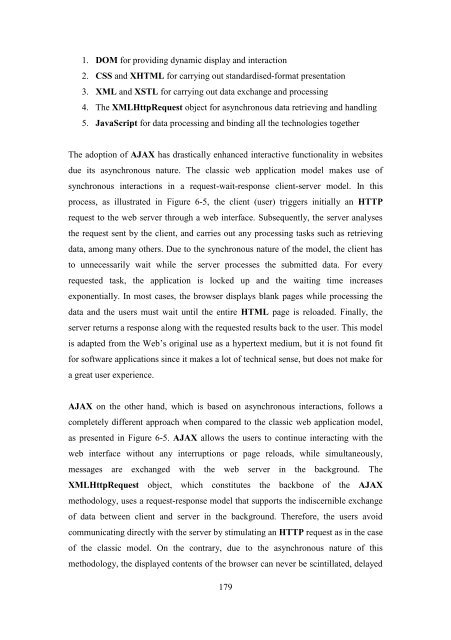CRANFIELD UNIVERSITY Eleni Anthippi Chatzimichali ...
CRANFIELD UNIVERSITY Eleni Anthippi Chatzimichali ...
CRANFIELD UNIVERSITY Eleni Anthippi Chatzimichali ...
Create successful ePaper yourself
Turn your PDF publications into a flip-book with our unique Google optimized e-Paper software.
1. DOM for providing dynamic display and interaction<br />
2. CSS and XHTML for carrying out standardised-format presentation<br />
3. XML and XSTL for carrying out data exchange and processing<br />
4. The XMLHttpRequest object for asynchronous data retrieving and handling<br />
5. JavaScript for data processing and binding all the technologies together<br />
The adoption of AJAX has drastically enhanced interactive functionality in websites<br />
due its asynchronous nature. The classic web application model makes use of<br />
synchronous interactions in a request-wait-response client-server model. In this<br />
process, as illustrated in Figure 6-5, the client (user) triggers initially an HTTP<br />
request to the web server through a web interface. Subsequently, the server analyses<br />
the request sent by the client, and carries out any processing tasks such as retrieving<br />
data, among many others. Due to the synchronous nature of the model, the client has<br />
to unnecessarily wait while the server processes the submitted data. For every<br />
requested task, the application is locked up and the waiting time increases<br />
exponentially. In most cases, the browser displays blank pages while processing the<br />
data and the users must wait until the entire HTML page is reloaded. Finally, the<br />
server returns a response along with the requested results back to the user. This model<br />
is adapted from the Web’s original use as a hypertext medium, but it is not found fit<br />
for software applications since it makes a lot of technical sense, but does not make for<br />
a great user experience.<br />
AJAX on the other hand, which is based on asynchronous interactions, follows a<br />
completely different approach when compared to the classic web application model,<br />
as presented in Figure 6-5. AJAX allows the users to continue interacting with the<br />
web interface without any interruptions or page reloads, while simultaneously,<br />
messages are exchanged with the web server in the background. The<br />
XMLHttpRequest object, which constitutes the backbone of the AJAX<br />
methodology, uses a request-response model that supports the indiscernible exchange<br />
of data between client and server in the background. Therefore, the users avoid<br />
communicating directly with the server by stimulating an HTTP request as in the case<br />
of the classic model. On the contrary, due to the asynchronous nature of this<br />
methodology, the displayed contents of the browser can never be scintillated, delayed<br />
179
















